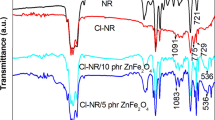Abstract
Fluorine rubber (FKM) is often used in bearing seals, bearing seal will be affected by high temperature in the process of use and performance decline. Therefore, in this paper, the effect of CeO2 on the high temperature composite properties of FKM was studied by filling CeO2 nanoparticles into FKM. 5% CeO2/FKM composites were prepared by mechanical blending and hot-pressing process after nano CeO2 was treated with silane coupling agent KH-570. After mechanical and high temperature friction tests of CeO2/FKM composites, the morphology of CeO2/FKM composites was characterized by three-dimensional topography instrument and scanning electron microscope. The mechanical strengthening mechanism and anti-wear and anti-friction mechanism of CeO2 on FKM were expounded. The results showed that the microstructure of Fluor elastomer with CeO2 particles was reinforced, and the defects of fluorine rubber itself were filled. Specifically, compared with the original FKM, the strength of CeO2/FKM composite was improved, in which the tensile strength reached 20.75 MPa, increased by 18.5%, and the tear strength reached 43.44 N/mm, increased by 3.5%. CeO2/FKM composites show outstanding anti-wear and low friction coefficient properties at high temperature (200 °C). The main mechanism is that nano-CeO2 keeps high hardness of FKM, and CeO2/FKM composites have high crosslinking density.




















Similar content being viewed by others
References
He Q, Zhou YJ, Wang GF et al (2018) Effects of two nano-ZnO processing technologies on the properties of rubber. Appl Nanosci 8:2009–2020
Ke YC, Yao XF, Yang H et al (2017) Gas leakage prediction of contact interface in fabric rubber seal based on a rectangle channel model. Tribol Trans 60(1):146–153
Yang H, Yao XF, Ke YC et al (2016) Constitutive behaviors and mechanical characterizations of fabric reinforced rubber composites. Compos Struct 152:117–123
Han RJ (2019) Thermal stability of CeO2/graphene/phenyl silicone rubber composites. Polym Testing 75:277–283
Nan X (2005) application and development of FKM. China Petroleum and Chemical Industry 3:26–29
Hu Xinsong Hu, Jiwen LK, Meichan Z (2014) FKM Overview. Guangdong Chemical Industry 41(4):49–50
Hongzhang C, Jiemin L, Yuxi Z et al (2014) Research progress of FKM modification technology. Rubber Industry 61(3):187–191
Qian Y, Fengbo C, Teng W et al (2019) Application of FKM in aerospace field. Chemistry and Adhesion 1:62–67
He Q (2019) Experimental investigation on large deformation of silicon rubber. J Polym Res 26:187–219
Ke YC, Yao XF, Yang H et al (2017) The compression and friction of tubular rubber seal under the curved surface loading. Proc Inst Mech Eng J J Eng Tribol 231(1):14–22
He Q, Zhou YJ et al (2019) Wear property improvement by short carbon fiber as enhancer for rubber compound. Polym Test 8(77):1–10
He Q, Li AL, Zhang Y et al (2018) A study on mechanical and tribological properties of silicone rubber reinforced with white carbon black. Tribol Mater Surf Interfaces 1:9–16
Chopin L, Goujon L, Ailing S (2013) Tensile stress-strain behavior of FKM/ carbon nanotube composites. Synthetic Rubber Industry 4:274–278
Xiaobo F, Huang C, Zhu L (2008) Study on friction and wear characteristics of FKM filled with graphite and molybdenum disulfide. Lubrication and Sealing 33(3):77–80
Chen D, Yan Q, Wang Y et al (2017) study on friction and wear properties of organically modified carbon fiber /FKM composites. New Chemical Materials 11:128–131
Qu M, Yao Y, He J et al (2016) Application of modern analytical testing technology in tribology of nanomaterials. Materials Herald 30(12):50–58
Gan TF, Shentu BQ, Weng ZX (2008) Modification of CeO2 and its effect on the heat-resistance of silicone rubber. Chin J Polym Sci 26(04):489
Chen P, Liu J, Guan Y et al (2014) Study on heat resistance of fluorosilicone rubber by metal CeO2 [C]// 2014 National Symposium on Polymer Materials Science and Engineering
Zhao G, Shi L, Feng X et al (2012) Palygorskite-cerium oxide filled rubber nanocomposites[J]. Appl Clay Sci 67(68):44–49
Yanjun R, Guan C, Wenming L (2006) Influence of rare earth CeO2 on rubber properties. World Rubber Industry 33(5):13–15
Sun D, Li X, Liu Z et al (2015) Effect of CeO2 on properties of chloroprene rubber. Funct Mater 46(6):15–19
Zhang F, Wang Y, Li P et al (2014) Study on surface modification of nano-CeO2 by silane coupling agent. Guangdong Chemical Industry 41(19):48–49
Hongwu D, Yufeng W, Puxuan Y et al (2018) Preparation and characterization of CeO2 / fibrous sepiolite co-modified fluor rubber composites. China J Rare Earths
Qi M, Jia X, Shi J et al (2021) Study on high temperature performance of fluor elastomer composites with different fillers. Lubrication and Sealing 46(2):106-113
Funding
This research project was supported by project of scientific and technological innovation talents of universities in Henan Province (19HASTIT023).
Author information
Authors and Affiliations
Corresponding author
Ethics declarations
Conflicts of interest
No potential conflict of interest was reported by the authors.
Additional information
Publisher's Note
Springer Nature remains neutral with regard to jurisdictional claims in published maps and institutional affiliations.
Rights and permissions
About this article
Cite this article
Han, J., Li, Z., Xu, Z. et al. Study on high temperature composite properties of ternary fluor rubber filled with nano-cerium oxide. J Polym Res 28, 487 (2021). https://doi.org/10.1007/s10965-021-02853-y
Received:
Accepted:
Published:
DOI: https://doi.org/10.1007/s10965-021-02853-y




